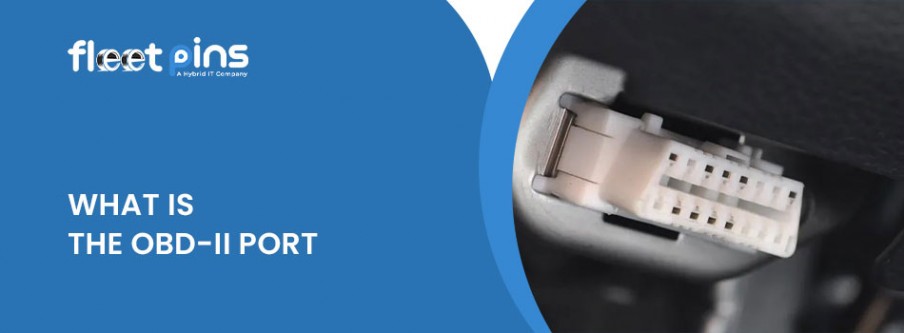
- On 2024-09-24
What is the OBD-II Port? | Everything You Need to Know About Vehicle Diagnostics
The On-Board Diagnostics II (OBD-II) port is an essential feature found in almost every vehicle manufactured after 1996. This small but powerful component provides access to the vehicle's computer system and is key to understanding how a car is performing. At Fleet Pins let’s explore what the OBD-II port is, how it works, its benefits, and how it has revolutionized the automotive industry.
A Brief History of the OBD-II Port
Before the OBD-II system, car diagnostics were not standardized. Automakers had their own systems, and mechanics needed different tools and knowledge to diagnose issues with cars from different brands. The need for a universal system led to the development of the OBD-II standard, which became mandatory in the United States in 1996. This standardization not only improved vehicle diagnostics but also played a key role in reducing vehicle emissions, as monitoring helped maintain engines in better condition.
How Does the OBD-II Port Work?
When a vehicle is running, its sensors are constantly sending data to the onboard computer. This data includes information about the engine's performance, fuel efficiency, emissions, and more. When something goes wrong, the OBD-II system generates a Diagnostic Trouble Code (DTC). These codes are stored in the computer and can be accessed by connecting a diagnostic scanner to the OBD-II port.
The scanner reads these codes and translates them into a readable format, helping mechanics or even car owners identify what the issue might be. For example, if the vehicle’s oxygen sensor detects a problem, the OBD-II system will generate a code that pinpoints the issue, allowing for timely repairs.
You May Also Read: How to Choose the Right GPS Tracking Device: A Comprehensive Guide
What Can You Do with the OBD-II Port?
One of the primary uses of the OBD-II port is to diagnose problems in the vehicle. When the "Check Engine" light comes on, you can use a scanner to determine the problem by reading the error code stored in the car’s ECU. This saves time and money as it helps narrow down the issue before going to a mechanic.
Monitor Vehicle Performance
Beyond troubleshooting, the OBD-II port provides real-time data about how your car is performing. With the right tools, you can monitor things like fuel consumption, engine temperature, and speed.
Clear Fault Codes
After fixing a problem, the OBD-II system allows you to clear the diagnostic codes and reset the "Check Engine" light. This ensures that any future issues trigger a new warning, rather than being overshadowed by previous codes.
Track Emissions
Emission testing is a key function of the OBD-II system. It monitors exhaust systems to ensure that vehicles comply with emission standards, reducing their environmental impact.
Vehicle Customization
Some advanced users leverage the OBD-II port to tune or modify their vehicle's settings. For instance, it can be used to improve performance, alter fuel efficiency, or change how certain systems, like air conditioning, behave.
You May Also Read: How GPS Vehicle Tracking Can Transform Fleet Management?
Why is the OBD-II Port Important?
The OBD-II port is a crucial tool for anyone who wants to keep their vehicle in good condition. Its importance can be seen from several perspectives:
Cost-Efficiency
Knowing exactly what is wrong with your car can save a lot of time and money. Instead of guessing the problem or paying for unnecessary repairs, a quick scan of the OBD-II system gives accurate diagnostic information, leading to quicker and more precise fixes.
Environmental Benefits
The OBD-II system helps reduce vehicle emissions by monitoring the engine and exhaust systems. Early detection of issues related to emissions can prevent the vehicle from producing excessive pollutants, contributing to cleaner air and reducing environmental impact.
Ease of Use
Even though the OBD-II system sounds technical, it’s designed to be user-friendly. OBD-II scanners are readily available and easy to use, making it possible for car owners to diagnose problems without requiring specialized knowledge or expensive equipment.
Safety
The OBD-II port helps identify issues that may affect vehicle safety. For example, problems with the transmission or engine can be detected early, allowing for timely repairs and preventing more significant breakdowns or accidents on the roads.
You May Also Read: Top Benefits of Implementing GPS Trackers in Fleet Operations
OBD-II Codes and What They Mean
OBD-II diagnostic trouble codes (DTCs) are standardized and consist of five characters. Here’s a quick breakdown:
- The first character is a letter, which represents the system that triggered the error
- The second character indicates whether the code is manufacturer-specific (1) or universal (0).
- The third character points to the specific system, such as fuel, ignition, or emissions.
- The final two numbers identify the exact issue.
For example, P0171 is a common OBD-II code, and it means that the engine is running lean (too much air and not enough fuel).
OBD-II Port Compatibility
One of the most significant advantages of the OBD-II system is its universality. Almost every vehicle manufactured after 1996 in the United States uses this system, regardless of the make or model. This standardization makes it easier for mechanics, DIY enthusiasts, and even car owners to diagnose and repair vehicles without needing a brand-specific tool.
OBD-II Scanners: How to Use Them
To read data from the OBD-II port, you need a diagnostic scanner. These scanners range from basic plug-in devices that display simple codes to advanced models that connect via Bluetooth or Wi-Fi and show live data on your smartphone.
Fleet pins offer 4G OBD II GPS Track FP90 which is a plug-and-play 4G OBD tracker without wiring. It is easy install to on any vehicle with a standard OBD II connector.
Here’s a quick guide on how to use an OBD-II scanner:
- Locate the OBD-II Port: Usually under the dashboard, on the driver’s side.
- Plug in the Scanner: Simply connect the scanner to the OBD-II port.
- Turn on the Vehicle: Turn the key to the "On" position, but don’t start the engine.
- Read the Codes: Follow the instructions on the scanner to read any codes. Some scanners will provide detailed explanations, while others require you to look up the code.
- Interpret the Codes: If you have a basic scanner, you may need to search online or use an app to interpret the trouble codes.
- Clear the Codes: If you’ve fixed the problem, you can clear the codes and reset the “Check Engine” light.
Conclusion
The OBD-II port is more than just a diagnostic tool—it’s a gateway to understanding your vehicle’s health. From saving money on repairs to reducing emissions and enhancing safety, the OBD-II system has transformed the way we interact with and maintain our cars. Whether you’re a car owner looking to solve issues yourself or a professional mechanic, the OBD-II port is a vital feature in modern vehicles that provides critical insights into automotive performance.




